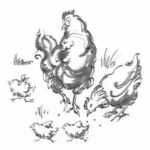 Paying a premium for free-range eggs might not buy you healthier eating, according to researchers at the National Cheng Kung University, in Tainan, Taiwan.
Paying a premium for free-range eggs might not buy you healthier eating, according to researchers at the National Cheng Kung University, in Tainan, Taiwan.
First, the details.
- 6 free-range eggs and 12 regular eggs from farms and markets in Taiwan were analyzed for their content of dioxins.
- “Dioxins” is the term used for polychlorinated dibenzo-dioxins (PCDDs) and polychlorinated dibenzo-furans (PCDFs).
And, the results.
- The free-range eggs contained 6 times higher levels of PCDDs and PCDFs than the regular eggs.
The bottom line?
The authors concluded, “Differences of PCDD/F levels… between free range and caged egg samples give rise to the issues related to the safety of eating free range chicken eggs.”
Taiwan is a heavily populated, industrialized island with many of the municipal incinerators that release PCDDs and PCDFs. How these findings relate to contaminants in eggs produced in the US or other industrialized countries isn’t known.
The authors defined “free-range” chicken in this study as having continuous access to fresh air, sunshine, and exercise, in contrast to chickens that are confined to cages. However, the term means different things in different countries.
6/19/10 19:29 JR